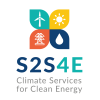Following successive amendments of the major energy directives, EU policy has in recent years become more supportive of the use of weather and climate services, a policy analysis by the S2S4E project shows.
The EU adopted its first rules for harmonising and liberalising its internal energy market in 1996, and the rules have since been updated four times. The last time was in 2019 with the completion of the fourth EU energy package, known as the Clean energy for all Europeans package, often referred to simply as the Clean Energy Package.
Over the same period, the EU’s targets for renewables in its final energy consumption have become increasingly more ambitious: from 12% in 2010 to 20% in 2020, and to 32% by 2030. And while the 2010 target was only indicative, the targets for 2020 and 2030 are legally binding.
Of all legislative documents on EU energy policy, it is the directives and regulations related to the security of electricity supply that most strongly encourage the use of subseasonal and seasonal forecasts, the S2S4E researchers behind the analysis concluded.
The EU’s renewables targets also provide indirect support to the use of subseasonal and seasonal forecasts. A larger share of weather-dependent renewable energy will make it more important for both grid operators and energy companies to skilfully forecast clean energy production to ensure that the total electricity generation can be managed to adequately meet demand.
That will likely lead to them becoming more interested in using tools or services that can help them make more accurate predictions of both electricity demand and the production of renewable energy.
First energy directives offered only indirect support
With each EU energy policy update, more detailed rules for how to ensure security of supply have been introduced. As a result, the legal incentives for using subseasonal and seasonal forecasts have become increasingly stronger.
The first EU electricity directive of 1996, Directive 92/92/EC, only indirectly supported the use of weather and climate services by encouraging the development of renewable energy. This directive was replaced in 2003 by the Internal Market in Electricity Directive (Directive 2003/54/EC), which went one step further by requiring monitoring of electricity supply and demand.
Two years later, Directive 2005/89/EC concerning measures to safeguard the security of electricity supply and infrastructure investments was introduced. This directive required Member States to also report on projected supply and demand and noted that there was a need for tools that could help anticipate demand-side variations.
Meanwhile, the word “forecast” was not mentioned in relation to supply and demand in any EU directive before 2009. Directive 2009/72/EC was then introduced as part of the Third Energy Package – replacing Directive 2003/54/EC – which was the first EU energy directive to make explicit reference to weather services.
It took another decade, however, before EU regulation explicitly acknowledged the risk that extreme weather conditions – such as cold spells and heatwaves – could pose to the electricity system. This was done with the comprehensive update of EU energy policy brought about by the implementation of the Clean Energy Package, which was completed in 2019.
Direct support introduced with the Clean Energy Package
The Clean Energy Package resulted in the introduction of the Risk Preparedness Regulation, which is the first EU regulation that explicitly mentions the need for forecasts for power demand and electricity supply at a seasonal timescale. For that reason, this regulation is the strongest policy support to date at EU level for using seasonal forecasts.
The Risk Preparedness Regulation requires that the European Network of Transmission System Operators for Electricity (ENTSO-E) carry out “seasonal adequacy assessments” twice a year – winter and summer – “to alert Member States and transmission system operators to risks related to the security of electricity supply that might occur in the following six months”.
The regulation also required ENTSO-E to develop a methodology to conduct these adequacy assessments. This methodology was adopted in March 2020. Moreover, the Risk Preparedness Regulation stipulates that the methodology should be updated “where significant new information becomes available”.
Seasonal adequacy assessments require the use of weather data
The aim of the seasonal adequacy assessments is, according to the new ENTSO-E methodology, to monitor whether available electricity supply and transmission capacity “are sufficient to cover demand under various weather and operational conditions on a temporal horizon of up to six months ahead”.
The methodology emphasizes that the adequacy assessments should consider the variability of both electricity demand and power production from renewable energy depending on weather conditions, and the impact of variable weather conditions on electricity demand and supply. It also stresses that data related to hydro inflows, solar radiation, wind speed and temperature “shall consider weather forecasts when available”.
Moreover, the methodology stipulates that month-ahead adequacy assessments are to be carried out and led by ENTSO-E if supply or network availability changes significantly compared with the assumptions used in the seasonal adequacy assessments and thereby cause an adequacy risk, or if an extraordinarily low supply and/or transmission availability is foreseen.
By referring to adequacy assessments for the month-ahead, the methodology also provides support for the use of subseasonal forecasts, as it is these predictions that offer insights into how the weather will evolve over the coming weeks.
ENTSO-E methodology does not mention subseasonal and seasonal forecasts
One shortcoming of the methodology is, however, that it does not require the use of subseasonal and seasonal forecasts to carry out the seasonal adequacy assessments. Instead, it just mentions weather forecasts, which typically only cover time spans for up to 10 days ahead.
Although the methodology here may refer to all kinds of weather and climate data, a future update of it should make the reference to subseasonal and seasonal forecasts explicit. By doing so, the methodology would stress the importance of such forecasts for estimating electricity supply and demand for longer time frames than just the next 10 days.
This is an excerpt from the ‘S2S4E white report: How subseasonal and seasonal forecasts can help the integration of renewables into Europe’s energy sector’. Please read the S2S4E white report for more information about existing policy support in Europe for the use of subseasonal and seasonal forecasts, the S2S4E project and its research on subseasonal and seasonal forecasts, and about how the energy industry can benefit from increasing its use of such forecasts.
Written by: Iselin Rønningsbakk / CICERO Center for International Climate Research


